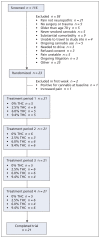Smoked cannabis for chronic neuropathic pain: a randomized controlled trial
- PMID: 20805210
- PMCID: PMC2950205
- DOI: 10.1503/cmaj.091414
Smoked cannabis for chronic neuropathic pain: a randomized controlled trial
Abstract
Background: Chronic neuropathic pain affects 1%-2% of the adult population and is often refractory to standard pharmacologic treatment. Patients with chronic pain have reported using smoked cannabis to relieve pain, improve sleep and improve mood.
Methods: Adults with post-traumatic or postsurgical neuropathic pain were randomly assigned to receive cannabis at four potencies (0%, 2.5%, 6% and 9.4% tetrahydrocannabinol) over four 14-day periods in a crossover trial. Participants inhaled a single 25-mg dose through a pipe three times daily for the first five days in each cycle, followed by a nine-day washout period. Daily average pain intensity was measured using an 11-point numeric rating scale. We recorded effects on mood, sleep and quality of life, as well as adverse events.
Results: We recruited 23 participants (mean age 45.4 [standard deviation 12.3] years, 12 women [52%]), of whom 21 completed the trial. The average daily pain intensity, measured on the 11-point numeric rating scale, was lower on the prespecified primary contrast of 9.4% v. 0% tetrahydrocannabinol (5.4 v. 6.1, respectively; difference = 0.7, 95% confidence interval [CI] 0.02-1.4). Preparations with intermediate potency yielded intermediate but nonsignificant degrees of relief. Participants receiving 9.4% tetrahydrocannabinol reported improved ability to fall asleep (easier, p = 0.001; faster, p < 0.001; more drowsy, p = 0.003) and improved quality of sleep (less wakefulness, p = 0.01) relative to 0% tetrahydrocannabinol. We found no differences in mood or quality of life. The most common drug-related adverse events during the period when participants received 9.4% tetrahydrocannabinol were headache, dry eyes, burning sensation in areas of neuropathic pain, dizziness, numbness and cough.
Conclusion: A single inhalation of 25 mg of 9.4% tetrahydrocannabinol herbal cannabis three times daily for five days reduced the intensity of pain, improved sleep and was well tolerated. Further long-term safety and efficacy studies are indicated. (International Standard Randomised Controlled Trial Register no. ISRCTN68314063).
Figures
Comment in
-
Volunteering overseas made easy.CMAJ. 2010 Oct 5;182(14):1493. doi: 10.1503/cmaj.100734. Epub 2010 Jun 7. CMAJ. 2010. PMID: 20530159 Free PMC article. No abstract available.
References
-
- Berger A, Dukes EM, Oster G. Clinical characteristics and economic costs of patients with painful neuropathic disorders. J Pain. 2004;5:143–9. - PubMed
-
- Mendell JR, Sahenk Z. Clinical practice. Painful sensory neuropathy. N Engl J Med. 2003;348:1243–55. - PubMed
-
- Attal N, Cruccu G, Haanpaa M, et al. EFNS guidelines on pharmacological treatment of neuropathic pain. Eur J Neurol. 2006;13:1153–69. - PubMed
-
- Mechoulam R. The pharmacohistory of Cannabis sativa. In: Mechoulam R, editor. Cannabinoids as therapeutic agents. Boca Raton (FL): CRC Press; 1986. pp. 1–19.
Publication types
MeSH terms
Substances
Associated data
Grants and funding
LinkOut - more resources
Full Text Sources
Other Literature Sources
Medical


